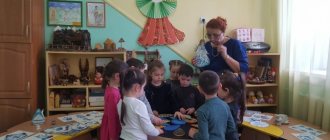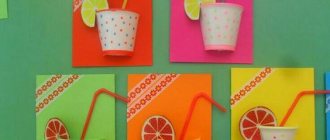Preparing for the drawing lesson “Dishes”
Drawing dishes is carried out simultaneously with the study of this topic in cognitive and speech classes. Children convey the characteristic features of everyday objects in drawings:
- shape (bowl, plate - round, cutlery - oblong),
- size (saucer smaller than plate, for example),
- color and pattern,
- purpose (glass - for compote, bowl - for vegetables).
Children can draw and paint dishes
Paints and base for painting
- Gouache is the paint of choice for painting with 5 year olds. Lines and strokes are clearly laid out, the color is rich. You can use watercolors (after all, these paints are cheaper than gouache).
- Brushes: thick and thin made of natural bristles.
- Colored pencils (not wax).
- Landscape sheet or half: white,
- tinted with watercolor paint (by the teacher).
Advice. Save markers for drawing details in the older group, and leave wax crayons for unconventional techniques with watercolors. The purpose of classes in the middle group is to teach object drawing with pencils and paints.
Gouache works best for children 4–5 years old to color.
Drawing technique
- Practice drawing shapes: with a finger/dry brush in the air or on a desk.
- Drawing an outline on paper (brush or pencil).
- Coloring: pencil shading,
- strokes of paint.
- border,
Painting utensils may include coloring and decorating
Video: drawing lesson for children “Cup and teapot”
The drawing lesson is intended by the author for children from three years old. In fact, primary and secondary preschoolers will be able to reproduce only part of what is shown in the video: the shape of a cup (semicircle) and a teapot (circle), painted over and completed with pens, a simple pattern.
Decorating a drawing or paper blank on the topic “Dishes” can be done using an unconventional technique:
- fingers,
- cotton swabs,
- stamps,
- imprinting dry leaves, cut fruits.
Photo gallery: drawings of dishes using non-traditional techniques
It’s fun to draw with a cotton swab; you get even peas
Children use their fingers to draw in the style of dot painting.
Leaf prints on the plate form a beautiful pattern
You can make stamps for decorating plates yourself: cut them out on pieces of vegetables
How to decorate a drawing
Aesthetic education of children is carried out in the interrelation of play, productive creativity, and the influence of the developing environment. Fine arts classes have one of the main objectives - to instill a sense of beauty in the younger generation. Stimulate and encourage the child’s desire to further decorate the drawing with various materials:
- plasticine circles (mosaic) or strokes (plasticineography),
- pieces of fabric, colored or wrapping paper (applique),
- glitter.
Plasticine elements can be used to mark the contours of dishes and make a three-dimensional pattern.
Individual tasks
An individual-personal approach to the work of a teacher is to adapt the conditions for each child in such a way that the tasks are feasible and at the same time develop. There are children in the group whose skills are still less developed than those of their peers - for them it is worth simplifying the task. But gifted children will quickly cope with the general task and get bored - they need more complicated tasks.
An example of multi-level tasks in the “Cup for Grandma” lesson:
- simplified - trace the stencil of the cup, outline the outline with gouache, paint over it, decorate with pieces of plasticine;
- general - draw a cup, color it, add a polka dot pattern;
- with a complication - draw a cup, decorate it in the style of folk crafts (Gzhel, Khokhloma).
In addition, you can individualize the task for everyone: through the choice of a tinted base, blank, stencil or paints. Children love being trusted to figure out some of the work themselves.
The ability to independently choose a subject to draw motivates children
Place of classes in the card index for visual activities
The topic “Utensils” is general and significant for different classes in the middle group. Children will learn what types of utensils exist and what materials they are made from. The culture of behavior at the table and eating food is covered in role-playing games.
During art classes, children depict familiar types of dishes. Individual works can be compiled into a collective composition. The theme of dishes and utensils is interpreted in drawing classes in a variety of formulations:
- “Cup for mommy”, “Tea pair” / “Cup and saucer for beloved grandmother” (for a gift on March 8),
- “Bowls of Three Bears” (individual composition to maintain proportions),
- “Treat for friends”, “Plate with vegetables/fruits” (drawing a base for plasticine fruits),
- “Gzhel patterns” (decorative drawing),
- “Dishes for Fedora” (collective composition based on the poem, the teacher draws Fedora based on it),
- “Tea service” (collective composition).
The drawings of all pupils can be arranged, for example, into the composition “Tea Party”








